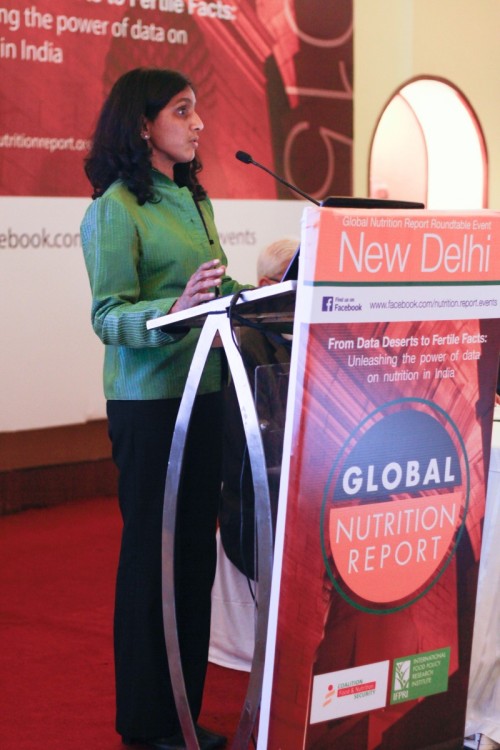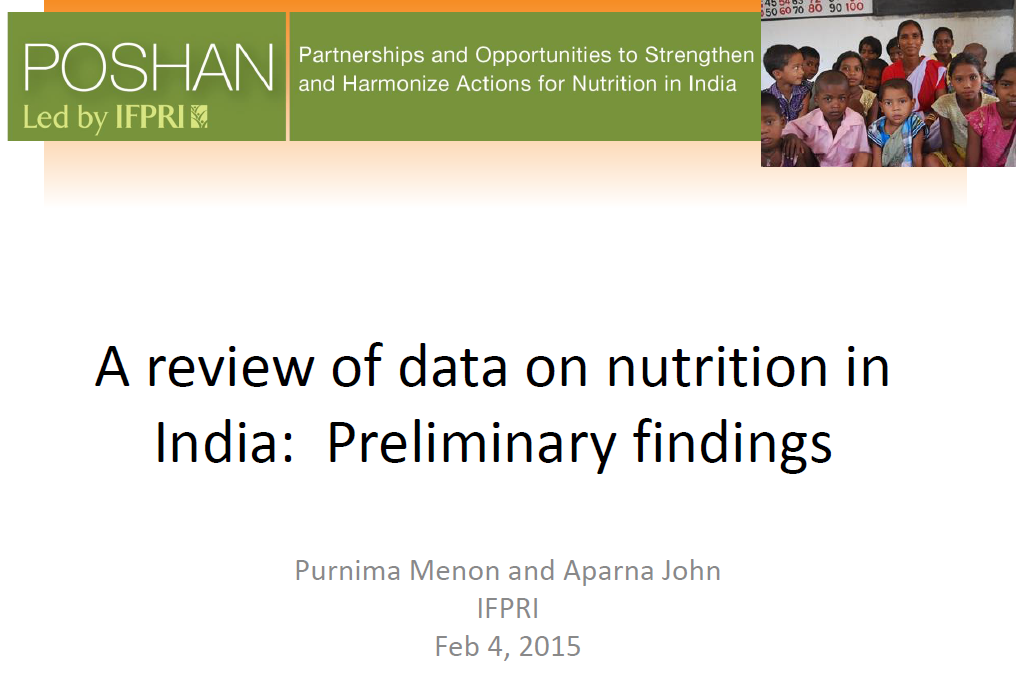 The first ever Global Nutrition Report (GNR), released globally in November 2014, was discussed at a stakeholder roundtable in New Delhi on February 4, 2015. The GNR selected a set of nutrition-related indicators to track progress of different countries on nutrition outcomes and several determinants of malnutrition, as well as potential actions to reduce malnutrition. The report featured 68 indicators across a series of themes related to the state of nutrition and its causes in several countries worldwide. Although the GNR Country Nutrition Profiles, also released along with the report in November 2014 included a country nutrition profile for India, we were struck by how few updated and relevant data sources were available to measure and track the status of these indicators in India. We decided then, to commence on a review of data on nutrition and its determinants in India. This blog summarizes the preliminary findings of this review, which we shared at the GNR stakeholder roundtable in New Delhi as well.
The first ever Global Nutrition Report (GNR), released globally in November 2014, was discussed at a stakeholder roundtable in New Delhi on February 4, 2015. The GNR selected a set of nutrition-related indicators to track progress of different countries on nutrition outcomes and several determinants of malnutrition, as well as potential actions to reduce malnutrition. The report featured 68 indicators across a series of themes related to the state of nutrition and its causes in several countries worldwide. Although the GNR Country Nutrition Profiles, also released along with the report in November 2014 included a country nutrition profile for India, we were struck by how few updated and relevant data sources were available to measure and track the status of these indicators in India. We decided then, to commence on a review of data on nutrition and its determinants in India. This blog summarizes the preliminary findings of this review, which we shared at the GNR stakeholder roundtable in New Delhi as well.
The presentation we made at the GNR roundtable in Delhi (see here) presents some of our preliminary findings.
Our emerging take-aways from the data review exercise are that the nutrition data situation in India is not simply one of a lack of timely data (which has been written about before). There are several other issues that limit our ability to look across data sources and over time. These include issues such as the following:
- Content: Not all surveys covered similar content areas; there was wide variability in content area coverage of the diverse health, nutrition and social sector surveys. This severely limits inferences about trends in either nutrition outcomes or the determinants of nutritional outcomes;
- Comparability: Not all surveys measured the same constructs (e.g., infant feeding) the same way or even targeted the same age group of respondents or children. This in turn starts to limit ways in which comparisons can be made over time, especially;
- Representativeness: Surveys varied substantially in whether they were representative at national, state or district level. This affects the level at which the survey results can be used for decision-making. Many states are developing nutrition strategies, and districts are engaged in health and nutrition planning; the lack of data can cripple the relevance of chosen actions;
- Data and documentation availability: Some survey data is readily available in the public domain, some on request, and not is yet unavailable. For some surveys, all survey documentation (manuals, questionnaires, sampling information) is available easily, making use and interpretation of the data much easier. For other surveys, little is available freely.
Overall, our primary recommendation from this work is that is imperative to hone in on a set of core indicators of nutrition outcomes and determinants of nutrition status and a mechanism for reasonably frequent (every 2-3 years) data collection to ensure that comparable data on these indicators is available for strategic nutrition-focused decision-making at national, state and district level. Are the indicators in the GNR Country Profile for India the right ones for decision-making in India? It isn’t quite clear, but what is clear is that a conversation about the right kind of data for strategy development is an important conversation to have.
To read the Global Nutrition Report 2014, click here
To view the GNR India Country Profile, click here
To download our data review presentation, please click the image below.
Want to discuss this with us? Email us at IFPRI-POSHAN@cgiar.org with “Data Review” in the subject line!



